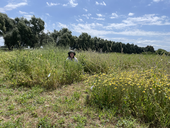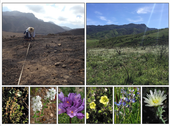- Author: Bradley Hanson
from a Weed Science Society of America press release (Oct. 11, 2014)
The U.S. Environmental Protection Agency (EPA) released an online toolbox with educational materials related to pesticides and endangered species -- another step in the agency's efforts to protect endangered species, support farmers, and provide critical environmental protections for communities across the country.
When EPA registers a pesticide or reevaluates it in
- Author: Justin Valliere
- Posted by: Sam Romano

One of the first steps in ecological restoration is often controlling invasive weeds, which can be a major barrier to native plant establishment. But what happens after restoration is complete? At most sites, weed pressure is an ongoing challenge that land managers must grapple with to maintain the diversity, structure, and functioning of native plant communities.
The Invasive Weed & Restoration Ecology Lab at UC Davis is currently exploring the use of “competitive planting” as a method for weed suppression in restored grassland communities. As part of a USDA-funded project, we are evaluating what seed mixes can best facilitate the establishment of native perennial bunchgrasses while also preventing reinvasion of...
- Author: Bradley Hanson
A colleague and a graduate student at Cornell University are conducting a survey to assess grower attitudes towards establishing wildflower strips as part of conservation programs and asked me to share the survey link to broaden the response to include California growers.
From the Cornell team: We are conducting a survey on grower attitudes towards establishing wildflower strips. This survey is part of a project we are doing on using seed pellets to establish wildflower strips. The basic idea of the project is to put multiple small wildflower seeds into a seed pellet the size and shape of a field crop seed. These pellets could then be planted using standard grain drills/planters, significantly...
- Author: Justin Valliere

Wildfire is an important ecological process that shapes patterns of plant diversity in many Mediterranean ecosystems, including California. In coastal sage scrub and chaparral, for example, plant diversity is often highest in the growing seasons immediately after a site burns, with many fire-following species emerging from the soil seed bank and bud bank. This often results in spectacular displays of wildflowers when sufficient rainfall occurs following fire.
In a recent study published in Global Change Biology, however, we found that persistence of these unique, fire-following wildflowers may be threatened by invasive plant species as well as nitrogen...
- Author: Justin Valliere
- Author: Jennifer Funk
A recent article in the LA Times argued that California native plants should not be the only option for drought-tolerant landscaping. Missing from this perspective was a discussion of the severe threat that many non-native plants pose to California's unique and biodiverse ecosystems including reduced native plant establishment and increased fire risk. Additionally, we know that the nursery trade plays an important role in driving these invasions. For example, a recent study by researchers at the...


